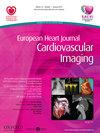Incremental value of right atrial strain analysis to predict atrial fibrillation recurrence after electrical cardioversion
引用次数: 0
Abstract
Abstract Funding Acknowledgements Type of funding sources: None. Background Atrial fibrillation (AF) is the most frequent cardiac arrhythmia, associated with elevated risks of cardiovascular events and death. The assessment of left atrial (LA) mechanics has been reported to refine AF risk prediction, however it does not completely predict AF relapse. The potential added role of right atrial (RA) function in this setting is unknown. Purpose This study sought to evaluate the added value of RA longitudinal reservoir strain (RARS), on top of LA longitudinal reservoir strain (LARS) analysis, for the prediction of AF recurrence after electrical cardioversion (ECV). Methods We retrospectively studied 132 consecutive adult patients (men 55%, 72±10 years) with persistent AF undergoing ECV in hospital setting. Exclusion criteria were: pregnancy, previous cardiac surgery, pacemaker or implantable cardioverter defibrillator, severe valvular regurgitation/stenosis, ventricular systolic dysfunction, poor apical acoustic window, unsuccessful ECV, early recurrent AF and lack of follow-up. LA and RA size and function were analyzed by conventional 2D and speckle-tracking echocardiography before ECV. The endpoint was AF recurrence. Results After a total follow-up of 12 months, 63 patients (48%) showed AF recurrence. Both LA and RA reservoir strain were significantly lower in patients experiencing AF recurrence than in patients with persistent sinus rhythm (LARS 10±6 vs 13±7%, RARS 14±10 vs 20±9 %, respectively, p<0.001 for both). By receiving operating curve (ROC) analysis, the best cut-offs associated to AF recurrence after ECV were 15% for RARS [AUC 0.77 (95%CI 0.69–0.84), p<0.0001] and 10% for LARS [AUC 0.69 (95%IC 0.60–0.77), p<0.0001]. Kaplan-Meier curves showed that patients with both LARS≤10% and RARS ≤15% had a significant risk for AF recurrences (log-rank, p<0.001) (Figure 1). However, at multivariable Cox regression, RARS [HR 3.26, 95%CI (1.73–6.13), p< 0.001] was the only parameter independently associated with the AF recurrence. RARS provided incremental prognostic value over LARS, LA and RA volumes concerning the prediction of AF relapse after ECV (Figure 2). Conclusions RARS was independently associated with AF recurrence after ECV and provided an incremental prognostic value over LARS. This study highlights the importance of assessing the functional remodeling of both RA and LA in patients with persistent AF. Figure 1. Atrial fibrillation recurrence freedom according to left and right atrial reservoir longitudinal strain. Kaplan-Meier plots of patients grouped according to the threshold levels of left (left panel) and right (right panel) values of reservoir longitudinal strain identified by the Receiver Operating Curve analyses.右心房应变分析对电转复后房颤复发的增量预测价值
资金来源类型:无。背景房颤(AF)是最常见的心律失常,与心血管事件和死亡风险升高相关。据报道,左心房(LA)力学评估可以改善房颤风险预测,但不能完全预测房颤复发。在这种情况下,右房(RA)功能的潜在附加作用尚不清楚。目的本研究旨在评价RA纵向储层应变(RARS)在LA纵向储层应变(LARS)分析基础上对电转复(ECV)后房颤复发的预测价值。方法回顾性研究132例持续性房颤患者(男性55%,72±10岁)在医院接受ECV治疗。排除标准为:妊娠、既往心脏手术、起搏器或植入式心律转复除颤器、严重的瓣膜返流/狭窄、心室收缩功能障碍、心尖声窗差、ECV不成功、早期复发性房颤和缺乏随访。采用常规二维超声心动图和斑点跟踪超声心动图分析ECV术前LA和RA的大小和功能。终点为房颤复发。结果随访12个月后,房颤复发63例(48%)。房颤复发患者的LA和RA库菌明显低于持续性窦性心律患者(LARS分别为10±6 vs 13±7%,14±10 vs 20±9%,两者均为0.01)。通过接收工作曲线(ROC)分析,与ECV术后AF复发相关的最佳截断值RARS为15% [AUC 0.77 (95%CI 0.69 - 0.84), p<0.0001], LARS为10% [AUC 0.69 (95%CI 0.60-0.77), p<0.0001]。Kaplan-Meier曲线显示,LARS≤10%和RARS≤15%的患者有AF复发的显著风险(log-rank, p<0.001)(图1)。然而,在多变量Cox回归中,RARS [HR 3.26, 95%CI (1.73-6.13), p<0.001]是唯一与房颤复发独立相关的参数。在预测ECV后AF复发方面,RARS比LARS、LA和RA体积具有递增的预后价值(图2)。结论RARS与ECV后AF复发独立相关,比LARS具有递增的预后价值。本研究强调了评估持续性房颤患者RA和LA功能重构的重要性。心房颤动复发自由度根据左右心房贮液纵向应变。患者的Kaplan-Meier图根据接受者工作曲线分析确定的储层纵向应变的左(左图)和右(右图)值的阈值水平分组。
本文章由计算机程序翻译,如有差异,请以英文原文为准。
求助全文
约1分钟内获得全文
求助全文

 求助内容:
求助内容: 应助结果提醒方式:
应助结果提醒方式:


